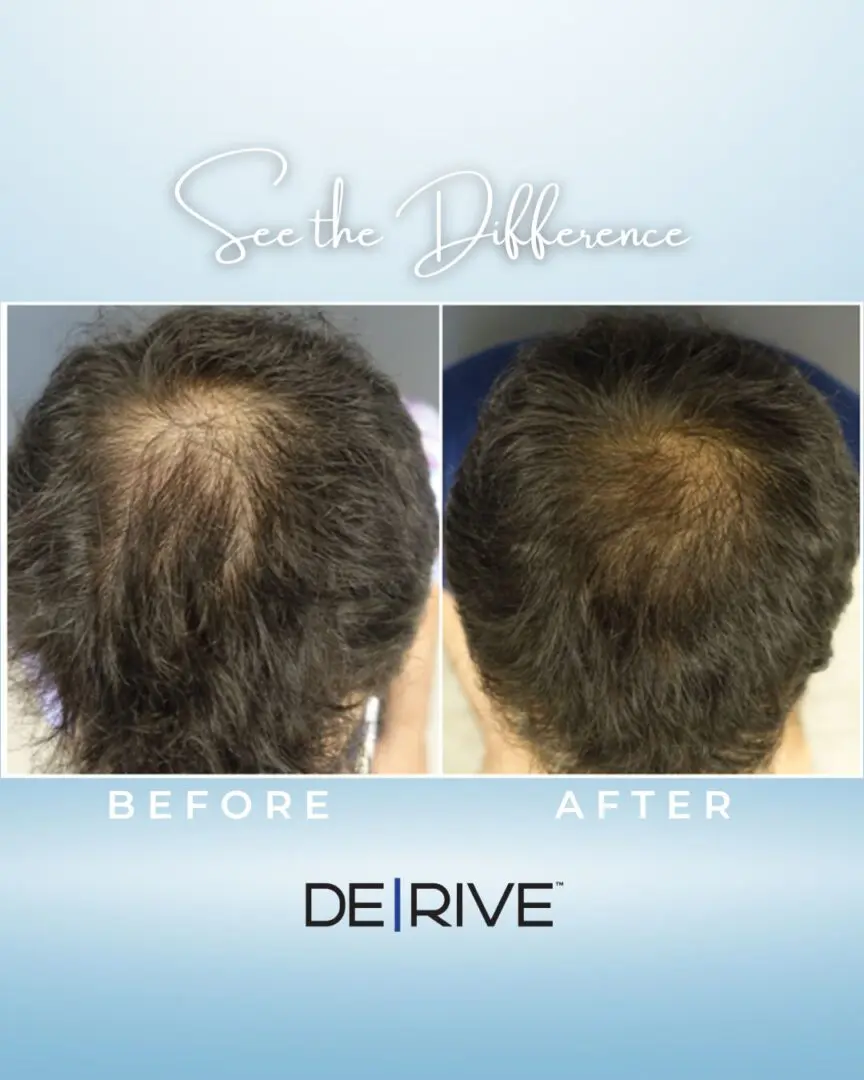
Hair Re-Growth Program using PRP (or in combination with Regenerative Cells)
Although hair loss is common, it can have a huge impact on a person’s self-esteem and, subsequently, their physical and mental wellbeing. PRP triggers natural hair growth and maintains that growth by increasing blood supply to the hair follicle and improving the hair shaft thickness. The procedure is quick, and results are typically visible within three months of PRP treatments.
- Non-Surgical
- Quick Procedure
- Safe & Reliable
- No Downtime
- Short Recovery Period
- Renowned for Natural Results
Genetics, Hormonal changes, Underlying medical conditions, Medications, Stress, Certain hairstyles

DE|RIVE™ Hair Wellness System
The DE|RIVE™ Hair Wellness System features both in-office and take-home products that patients love. The DE|RIVE™ Hair Wellness System is comprised of DE|RIVE™ In-Office Serum, DE|RIVE™ Take-Home Daily Support Serum, NEW DE|RIVE™ Daily Support Shampoo, and NEW DE|RIVE™ Leave-in Conditioner all powered by EXO|E™ Technology.
What makes the DE|RIVE™ Hair Wellness System, with the addition of our new products, such a comprehensive system is that it is carefully curated from well-studied, plant-based factors that support hair and scalp health.
This is a great combination with PRP or just as a stand alone treatment.
With PRP, blood from a patient is centrifuged into separate layers, including red blood cells, plasma, and a buffy coat layer where all the platelets are concentrated. This layer is separated from the others along with a small quantity of plasma and is thus termed platelet-rich plasma, in which the growth factors reside. Cells can be combined with mesenchymal cells injected into a site on the scalp and the results monitored over 6 months.
Recent research has found significant improvements in the hair density and hair count compared to placebo areas, suggesting that the above method for treating hair loss may have huge potential for other hair loss sufferers.
Procedure for hair loss therapy
The microneedling procedure is another method that stimulates growth factor release. Topical or injection of anesthesia can be used to decrease pain from the microneedling.
Area is anesthetized and a light microneedling procedure is carried out on area of treatment. Then the regenerative cells and/or PRP are combined and placed onto the area to absorb onto the scalp in areas of hair loss. Expectations will be that eventually the growth factors from both products will produce thicker, darker, healthier, and more cosmetically effective hair growth.
Treatments will always need to be repeated to be effective. A common program is one treatment session each month for three months, followed by a booster session every six months. Your practitioner will discuss your recommended treatment program and its rationale.
PRP injections are considered to be very safe. The substance injected is autologous, meaning it was obtained from the patient’s own body, eliminating the risk of blood or tissue borne pathogens. Assuming the procedure is carried out in an aseptic manner, there is little risk of infection from the injections themselves, although it is not possible to sterilize the surface of the scalp. Thus, local and temporary pain at the injection sites is the principal risk.
Stem cell therapy is a safe and effective treatment option for a wide range of conditions, including but not limited to spinal cord injuries, heart disease, autoimmune conditions, degenerative neurological disorders, and diabetes.
*Research for the different applications of PRP is promising and rapidly growing. Although the equipment used to produce PRP and the injections themselves have been cleared by the FDA, this procedure is considered investigational and has not been officially approved by the FDA for most uses. Since PRP is a substance derived from one’s own blood, it is not considered a drug. FDA clearance means that doctors can prescribe and administer PRP if they believe it’s in the best interest of the patient. However, lack of the FDA approval means that PRP treatments may not be covered by insurance.
